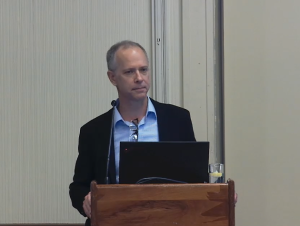What Is COP27?
By Olga Rukovets, originally published on the State of the Planet blog
You’ve likely seen the headlines about COP27, the United Nations (UN) Climate Change Conference that is taking place November 6–18 in Sharm el Sheikh, Egypt for its 27th year. But what actually happens there and what difference can it make?

IRI Director John Furlow has attended about a dozen COP meetings and will be at COP27 as well. Photo: Olga Rukovets
On November 3, John Furlow, director of Columbia Climate School’s International Research Institute for Climate and Society, presented COP101 for Students, an event breaking down the global climate summit—including who goes, what it is, and why it matters for climate action.
To put the conference into perspective, Furlow told the audience to think about flying on an airplane. Imagine, he said, 196 people on a flight with only two first-class passengers accounting for 4,000 pounds of luggage. There are 24 people in business class with another 4,000 pounds of luggage, and everyone else is riding in coach with a combined 2,000 pounds between them—just over 11 pounds per person.
Now imagine the pilot announces the plane is overweight and passengers will have to decide how to remove or redistribute excess luggage before anyone can take off. Who will have to make the most sacrifices—those who are already traveling light with barely a carry-on each, or those with surplus baggage who have the most resources to pay their way to the premier classes?
In a nutshell, these are the questions being asked of COP signatories—to decide among themselves how to stabilize and reduce global greenhouse gas emissions, Furlow explained. In this analogy, there is a reason just two passengers are in first class—China and the US are the biggest emitters of carbon dioxide and other greenhouse gases by a long shot, followed by the European Union. What, then, do China and the US owe to the countries (all the passengers in coach) who have to suffer the consequences of a rapidly changing planet? And what leverage do developing nations have to hold top emitters accountable?
Furlow discussed these and other key agenda items in his student primer on COP27.
Who participates in COP?
At the meetings, you will find the negotiators or representatives of the 196 countries (and the European Union) who have signed on to the UN climate framework, members of the UN Secretariat, and observer groups, such as other UN bodies, nongovernmental organizations, universities including Columbia Climate School, private companies, and religious groups, Furlow said. You may also find celebrities like Leonardo DiCaprio and Al Gore, as well as vegans handing out sandwiches outside the gates to encourage dietary changes as a way to reduce the global carbon footprint, he added, noting that it almost feels like a trade show.
During COP, there are simultaneous assemblies going on, including meetings of the members of the Kyoto Protocol, Paris Agreement, and other subsidiary agencies, Furlow said. And while the days theoretically run during traditional business hours, meetings frequently extend late into the night.
This grueling schedule is especially difficult for many delegates from developing countries that are already the hardest hit by climate change, as they often have to stay farther from the convention center because of exorbitant hotel prices near the venue. They spend additional time commuting, Furlow noted, creating a microcosm of some of the resource disparities the conference is trying to address. Some members pack their toothbrushes when they come to the meetings, he said.
What are the major topics at COP27?
Mitigation is the most important topic being discussed, Furlow told the room. How are we going to stop emitting so much carbon? How are we going to remove carbon from the atmosphere so the planet stabilizes at a level that will avoid dangerous consequences? How will we limit global temperature rise to 1.5 degrees Celsius?
In recent years, adaptation strategies—or adjusting to the damage that is already happening as a result of climate change—have also taken a more central role at COP; whereas in earlier conferences, the belief was that too much focus on adaptation would be an admission that mitigation efforts had failed, he said.
Additional key topics at this year’s COP include:
Loss and damage—whether and how nations who are the greatest contributors to climate change are responsible for compensating the small and developing countries that bear the brunt of the consequences.
Climate finance: Who will pay for these damages and how will the amounts be determined?
Capacity building: How will nations be provided with the training and infrastructure to use these funds in the most effective ways?
Action for climate empowerment: Can the empowerment of youth climate movements and education initiatives affect public sentiment and spur action?
Subnational action: What can states, cities, and other local groups do to effect change?
Private sector action: How will corporations and private companies contribute to climate initiatives and help countries meet their mitigation and adaptation goals?
What needs to happen for COP27 to be successful?
For COP27 to achieve real change, Furlow said we need more resources for adaptation; stronger commitments from individual countries—particularly those with the highest emissions; a plan to hold countries accountable when their mitigation and adaptation goals aren’t met; effective action on loss and damage, including consensus on the amount of money wealthier nations owe developing countries who are experiencing the fallout from climate change; and a focus on capacity building to ensure we use the right channels and initiatives to get funds to the people who need them most.
“The most important thing is not what happens at COP,” he told the audience. “It’s what happens when everybody comes home. If everybody comes home happy that they made commitments but we don’t follow through with action, nothing’s going to change.”

You must be logged in to post a comment.